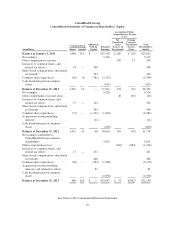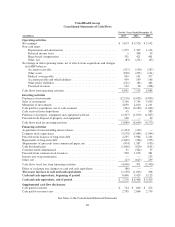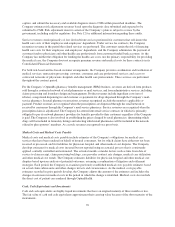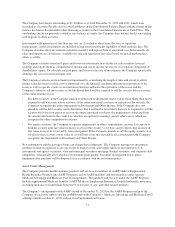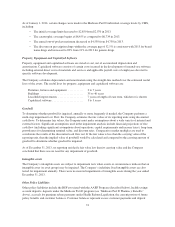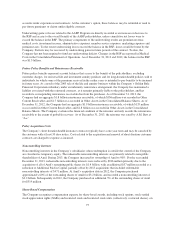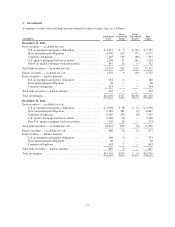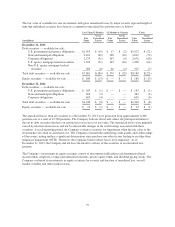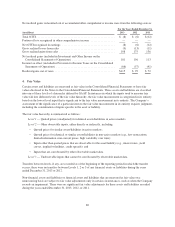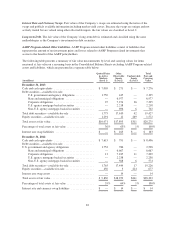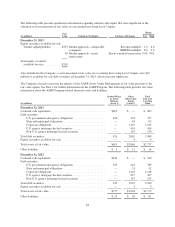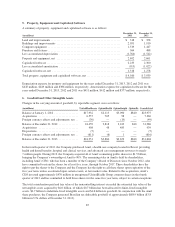United Healthcare 2013 Annual Report Download - page 78
Download and view the complete annual report
Please find page 78 of the 2013 United Healthcare annual report below. You can navigate through the pages in the report by either clicking on the pages listed below, or by using the keyword search tool below to find specific information within the annual report.a straight-line basis over the related service period (generally the vesting period) of the award, or to an
employee’s eligible retirement date under the award agreement, if earlier. Restricted shares vest ratably;
primarily over three to four years and compensation expense related to restricted shares is based on the share
price on date of grant. Stock options and SARs vest ratably over four to six years and may be exercised up to 10
years from the date of grant. Compensation expense related to stock options and SARs is based on the fair value
at date of grant, which is estimated on the date of grant using a binomial option-pricing model. Under the
Company’s Employee Stock Purchase Plan (ESPP) eligible employees are allowed to purchase the Company’s
stock at a discounted price, which is 85% of the lower market price of the Company’s common stock at the
beginning or at the end of the six-month purchase period. Share-based compensation expense for all programs is
recognized in Operating Costs in the Company’s Consolidated Statements of Operations.
Net Earnings Per Common Share
The Company computes basic net earnings per common share by dividing net earnings by the weighted-average
number of common shares outstanding during the period. The Company determines diluted net earnings per
common share using the weighted-average number of common shares outstanding during the period, adjusted for
potentially dilutive shares associated with stock options, SARs, restricted shares and the ESPP, (collectively,
common stock equivalents) using the treasury stock method. The treasury stock method assumes a hypothetical
issuance of shares to settle the share-based awards, with the assumed proceeds used to purchase common stock at
the average market price for the period. Assumed proceeds include the amount the employee must pay upon
exercise, any unrecognized compensation cost and any related excess tax benefit. The difference between the
number of shares assumed issued and number of shares assumed purchased represents the dilutive shares.
Recently Adopted Accounting Standards
In February 2013, the Financial Accounting Standards Board (FASB) issued Accounting Standards Updated
(ASU) No. 2013-02, “Comprehensive Income (Topic 220): Reporting of Amounts Reclassified Out of
Accumulated Other Comprehensive Income” (ASU 2013-02). ASU 2013-02 requires companies to report the
effect of significant reclassifications out of accumulated other comprehensive income, by component, either on
the face of the financial statements or in the notes to the financial statements and is intended to help entities
improve the transparency of changes in other comprehensive income. ASU 2013-02 does not amend any existing
requirements for reporting net income or other comprehensive income in the financial statements. ASU 2013-02
became effective for the Company’s fiscal year 2013 and the new disclosures have been included with the
Company’s investment disclosures in Note 3.
ASU No. 2011-06, “Other Expenses (Topic 720): Fees Paid to the Federal Government by Health Insurers a
consensus of the FASB Emerging Issues Task Force” (ASU 2011-06) addresses the recognition and classification
of an entity’s share of the annual health insurance industry assessment (the industry fee) mandated by Health
Reform Legislation. The industry fee is levied on health insurers for each calendar year beginning on or after
January 1, 2014 and is not deductible for income tax purposes. The amount of the industry fee for each health
insurer is based on a ratio of the insurer’s net health insurance premiums written for the previous calendar year
compared to the U.S. health insurance industry total net premiums. In accordance with the amendments in ASU
2011-06 on January 1, 2014, the liability for the industry fee payable in 2014 will be estimated and recorded in
full within the Company’s 2014 financial statements, with a corresponding deferred cost that will be amortized to
expense using a straight-line method of allocation over the calendar year that it is payable.
The Company has determined that there have been no other recently adopted or issued accounting standards that
had, or will have, a material impact on its Consolidated Financial Statements.
76



